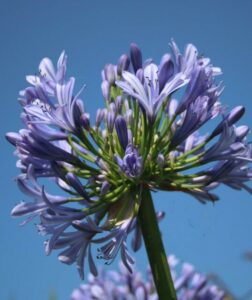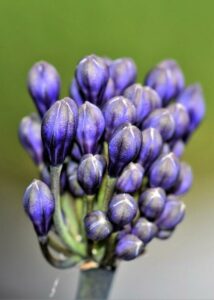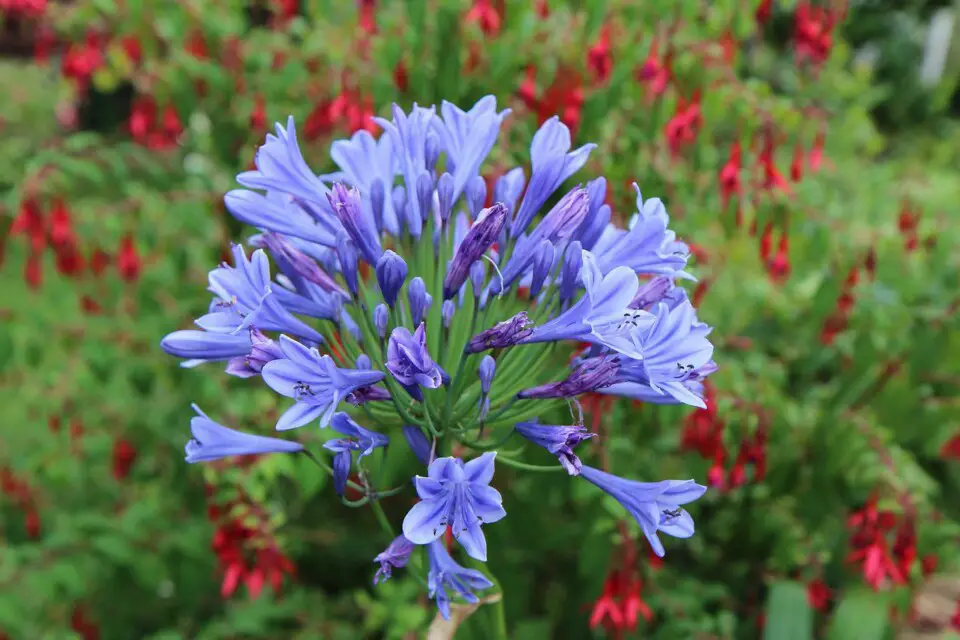Some links in the post are affiliate links and I get a commission from purchases made through some links found in the post.
Lily of the Nile, or Agapanthus, is cultivated throughout the balmy areas of the world, and North California is especially famous for its ploughing.
Like all vegetation, Agapanthus requires clear conditions for its growth and cultivation. The most essential aspect among those is the soil it is grown in.
If you’re fond of growing Agapanthus, you’ve clicked on the right article because we can answer all your questions!
Agapanthus is best planted in a moist but well-drained soil of sand, clay, chalk, or loam within an acidic, alkaline, or neutral pH balance.
The agapanthus is best positioned in full sun. They prefer their roots to be restricted, so they make excellent pot plants. They are also well suited to growing on borders.
But hang on! We have listed all the conditions that’ll help your Agapanthus not only sprout but bloom too, so stick to this article if you want to grow the best quality Agapanthus!
What Soil Nutrients does the Agapanthus Need?
Like all vegetation, Agapanthus requires the right mix of nutrients for unparalleled growth. Below is a brief description of all the nutrients essential for Agapanthus:
1) Nitrogen
As expected, The first name on the list had to be nitrogen. Without a doubt, this is one of the most important nutrients for most plants as it is essential for the development of both stems and leaves.
If you see that your Agapanthus grows very slowly, it may need more nitrogen!
2) Phosphorus
Phosphorus is a nutrient that is the main constituent of many essential plant processes and mechanisms. Among these, the first one that crosses one’s mind is photosynthesis.
Arguably the most salient mechanism on planet Earth was converting solar energy into chemical energy and providing it to millions of animals and humans alike for growth and nutrition.
Moreover, Phosphorus helps in the development of roots and the generation of fruits, seeds, and flowers. It will also help your Agapanthus fight many illnesses.
3) Potassium
The third nutrient that plays an important role in the nourishment of Agapanthus is Potassium. It is vital for many mechanisms such as photosynthesis and translocation of photosynthesis.
Also needed for protein synthesis and enzyme activation. In summary, we can ensure that it helps the development of strong stems with a reasonable growth rate, as well as increasing resistance to periods of drought and the presence of any disease.
This tells you about how important Potassium is for the nourishment of Agapanthus.
You may also like: Why are your agapanthus leaves turning yellow
What Type of Soil Should you Use for your Agapanthus?

Being a gardener, one must know the exact kind of soil to grow its seedlings in if they want to get optimum growth.
This article will provide you with a detailed, in-depth view of the best kind of soil suited for Agapanthus.
The soil required by Agapanthus should be moist and well-drained. The soil has no preference for pH except for Agapanthus Africanas, which require a slightly acidic pH.
The plant cannot stand ‘wet feed.’ Hence the soil should be well-drained. A mixture of loamy soil and compost can be used. Soil can be mixed with grit to improve drainage.
The soil should be placed under the sun for better cultivation. Growing your Agapanthus under these conditions would ensure maximum growth and sustenance of your plant.
What Signs Show you are Using the Wrong Soil for your Agapanthus?
One of the most recurrent and prominent signs of Agapanthus being grown in the wrong soil is them not producing any flowers.
Yes! If your Agapanthus is not producing any flowers, there is a great chance that you may be growing it in the wrong soil. Another common sign of cultivation in the wrong soil is a disease called ‘Root Rot.’
A handful of fungi and water molds (Oomycetes) can cause root rot. Fortunately, you can prevent this disorder by making sure that your plants have good drainage and are not overwatered.
Thus, Saturated, waterlogged soil deprives the roots of oxygen, and in their weakened state, they are vulnerable to attack.
Plants affected by root rot may display reduced growth or wilting foliage. In many cases, they won’t present any symptoms until the damage has gone beyond repair. This tells you the significance of keeping the soil well-drained!
You also like: Agapanthus light requirements
What Should be the Right pH for your Agapanthus?
Another thing that must be kept in mind while growing Agapanthus is the suitable pH.
Growing them at the proper pH is necessary because even a slight alteration of soil pH can cause stunted growth in your plant and have deleterious effects.
Agapanthus usually isn’t very picky regarding soil pH, and a wide range of pH from 5.5-7 can succor the plant to grow.
Generally, this plant has no preference for pH, although some species, such as the Agapanthus Africans, require slightly acidic soil.
Our 5 Recommended Soils for Agapanthus
Below is the list of the types of soils that will make your Agapanthus blossom. These soils have been carefully chosen for the masses for them to grow the perfect batch of Agapanthus.
So without further ado, let’s find out the most exquisite soil for your Agapanthus!
1) Mineral Gro Potting mix 16qt
First on the list and perhaps the best of the lot is the Mineral Gro Potting mix. It grows your plant twice as big as unfed plants.
Yes! This soil will nurture your plant to almost double the amount compared to an unfed plant. Moreover, it feeds for up to 6 months. It is durable and everlasting and fosters your plant very well.
Furthermore, this product makes your plant burgeon more colors than unfed plants. On top of all this, this soil can be used for indoor and outdoor container plants and in containers. For these reasons, this soil is rated at 4.7 on Amazon.
2) Miracle-Gro Indoor Potting Mix 6 qt
Among Miracle-Gro Indoor Potting Mix 6 qt salient features, the most predominant is that it has been blended for a wide diversification of container plants.
Thus, it can be used for a variety of vegetation to get adequate nourishment. It feeds for up to 6 months, so it is very enduring.
Furthermore, it is designed to be less prone to gnats as it contains no compost or bark, known to shelter Fungus Gnats. It contains coconut coir.
This substance holds and releases water and helps soil easily re-wet. Henceforth, this soil type is perfect for Agapanthus, which requires a controlled amount of water for ample growth.
3) Espoma Organic Potting Soil Mix
Next on our list, The Espoma Organic potting soil mix is indispensable if you are into gardening. This easy-to-use potting mix is not just indoor potting soil.
This can also be used as potting soil for outdoor plants and is an excellent soil mix for vegetables, herbs & all other container plants & flowers.
This soil is a rich blend of sphagnum peat moss, humus & perlite enriched with earthworm castings, alfalfa meal, kelp meal & feather meal.
Furthermore, it is a perfect proprietary blend of endo & ecto mycorrhizae. But when should one use this soil? Well, it can be used anytime in planting containers, whether starting a new plant or transplanting into a larger container.
Last but not least, this soil only contains natural ingredients that are ideal for any plant to grow, which is why this soil has a 4.6 rating on Amazon!
4) Miracle-Gro Seed Starting Potting Mix
Next up is the Mineral gro seed starting potting mix. Another household name for growing plants, among its salient features, is its ability for fast root development.
It is enriched with Miracle-Gro Plant Food, which is excellent for the nourishment of seedlings and yields quick results.
Moreover, this soil is topnotch for starting cuttings, and it can also be used when starting from seed and with leaf, stem, or root cuttings. All of these features have earned seed starting potting mix a 4.7 rating on Amazon.
5) SUN GROGRO HORTICULTURE Black Gold
Lastly, we have the Sungro horticulture Black Gold. Made in the United States, it was listed by the organic materials review institute for producing organic food and fiber.
Its rich, loamy mix is one of the best for all gardening applications. It contains perlite and pumice to ensure optimum pore and air space for sturdy growth. All of these hallmarks have earned this product a 4.6 rating on Amazon.
Is Tomato Feed Good for Agapanthus?
YES! Tomato feed is a superb choice for Agapanthus. They not only surge the size of growing flowers but also help sprout more flower spikes
They will also benefit from a fortnightly feed of liquid high-potash tomato food during the growing season.
Tomarite has a high potash content which aids in most plants’ germination of Flowers and Fruit. This is why it is used by most farmers during the growing season for preferable results.
You may also like: 5 great planting combinations with your agapanthus
How to Repot a Agapanthus?
Before answering, how? Let’s have a small brief on when we should re-pot Agapanthus.
The signs include lack of flowering, many roots emerging from the drainage holes at the base, and difficulty getting the roots out of the container because they are crammed there. The re-potting procedure is as follows:
- Pry the plant from the existing pot.
- Ready a new container slightly larger than the one you are using.
- Place your plant in the new container
- Fill around the plant with a peat-free loam-based potting mix with added grit or sand for drainage.
- Water the plant and addition of grit and gravel for decoration.
Though Agapanthus likes to be a little squashed and can cope surprisingly well with cramped conditions, you will have to re-pot it after every four years to ensure cromulent ballooning.
The video below should give you a more in-depth understanding on how to repot an agapanthus.
When to Divide Agapanthus in Pots?
The first thing you need to know before cleaving your Agapanthus is whether your variety is Evergreen or deciduous.
Don’t ever think about dividing when they are flowering and are giving your mesmerizing blossoms. You have to wait till the flowering season is over.
You should split and transplant your Agapanthus for evergreen varieties every 4 to 5 years. Do the actual carving when new growth emerges in spring, or else in early autumn after the plants have concluded flowering.
This timing works for deciduous plants too. However, they should be dissected every 6 to 8 years. Personally, we would suggest that the middle of September or October is the right time to slice up your plant.
Another indication that your plant needs dividing is its lack of flower production. Hence the moment you realize that they are churning out fewer flowers, get to work because it is time to sunder them!
Remember that fertilizing the plant is also essential for its propagation. In the weeks leading up to flowering, use a balanced liquid fertilizer.
Overfeeding the plant will cause them to cease blossoming. Unless the seed is required for multiplication, remove flower heads after blossoming.
In the winter, especially in cold places. Apply a dry mulch, removing the straw or sand before the active growth phase.
Final Thoughts
 Agapanthus is an easy-to-cultivate plant, and although it does require some specific soil types, it generally is easy to grow.
Agapanthus is an easy-to-cultivate plant, and although it does require some specific soil types, it generally is easy to grow.
Well-drained soil of sand, clay, chalk, or loam within an acidic, alkaline, or neutral PH balance is best for its husbandry.
Nitrogen, Potassium, and Phosphorus, or NPK, are among the chief nutrients required for its satisfactory growth.
Root rot or less production of flowers is among the primary manifestations that the soil type is substandard and needs replacing.
An unerring PH, a feed containing a sufficient amount of tomatoes together with our propounded soils. This is the right combination to grow prepossessing and eye-catching blossoms for your garden.
Agapanthus must be divided every 4 to 6 years for continued production of flowers. The fundamentals and particulars provided can be used for the steady growth of Agapanthus for many, many years!
About the Author:
Saad Ansar
Saad is an avid gardener himself and is a great lover of plants, animals, photography, & people. Currently, he is focused on photographing indoor plants & captioning beautiful outdoor sceneries. He writes and rewrites in-depth articles on nature and science.







